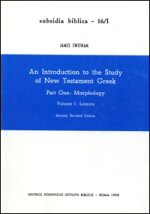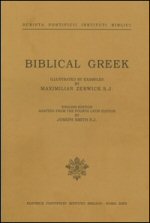Introduction to Biblical Greek Collection (3 vols.)
Digital Logos Edition
Overview
This collection features some of the finest resources available to the student beginning in New Testament Greek. In 100 lessons, it introduces basic Greek grammar, syntax, the morphology of New Testament Greek, and discusses many other grammatical items necessary for any novice NT Greek student.
On their own, these volumes are powerful tools for studying the Greek of the New Testament. Together, they constitute as much information as a full year’s worth of seminary education in Greek. A legacy of success in the classroom, now you can introduce yourself to New Testament Greek from your home computer with An Introduction to the Study of New Testament Greek Vols. 1 & 2 and Biblical Greek.
- Title: Introduction to Biblical Greek Collection
- Publisher: Editrice Pontificio Istituto Biblico
- Volumes: 3
- Pages: 972
This title is included in the following collections
You can save when you purchase this product as part of a collection.
Grammars Collection (90 vols.)
$829.99$829.99Verbum 8 Gold Legacy Library
$849.99$849.99Verbum 9 Gold Legacy Library
$849.99$849.99Pontifical Biblical Institute ...
$1,153.46$864.99
- $1,499.99$1,199.99
- $2,492.22$1,249.99
- $2,471.16$1,479.99
- $1,499.99
- $1,499.99
- $1,499.99
- $1,499.99
- $1,499.99
- $1,499.99
- $1,699.99
- $2,999.99$2,099.99
- $2,999.99$2,249.99
- $2,999.99$2,249.99
- $2,499.99
- $3,399.99$2,549.99
- $3,899.99$2,924.99
- $3,899.99$2,924.99
- $2,999.99
- $2,999.99
- $2,999.99
- $2,999.99
- $2,999.99
- $2,999.99
- $2,999.99
- $2,999.99
- $4,149.99$3,112.49
- $4,749.99$3,324.99
- $4,739.99$3,554.99
- $4,749.99$3,562.49
- $4,749.99$3,562.49
- $4,749.99$3,562.49
- $4,899.99$3,674.99
- $3,999.99
- $5,999.99$4,499.99
- $5,999.99$4,499.99
- $4,749.99
- $4,749.99
- $4,749.99
- $4,749.99
- $4,749.99
- $6,399.99$4,799.99
- $7,749.99
- $7,749.99
- $10,999.99$8,249.99
- $11,399.99
- $11,399.99
- $23,999.99$17,999.99
- $21,749.99
- $24,999.99

An Introduction to the Study of New Testament Greek, vol. 1 & 2
- Author: James Swetnam
- Publication Date: 1998
- Pages: 787
The Greek scholar Stanley E. Porter has called An Introduction to the Study of New Testament Greek Vols. 1&2 “by far the most comprehensive introductory volumes that I have ever read.” These two volumes are the culmination of the many decades Swetnam spent teaching elementary Greek at the Pontifical Biblical Institute in Rome. They are designed specifically for those who wish to study New Testament Greek without the aid of a teacher.
The text is constructed around 100 lessons, with sixty-seven comprising the basic grammar, fourteen lessons discussing grammatical items, and the last nineteen lessons being devoted to reading from the biblical text. It presumes that the beginner knows nothing about the Greek alphabet or the traditional categories of grammar which come from the Greco-Latin heritage. These categories are explained as the Greek of the New Testament is introduced.
In keeping with the author’s aim to give the student maximum exposure to the sacred text, the Greek text of Mark’s Gospel is tackled in the very first lesson. The rest of that Gospel, as well as the entire Gospel of John, are thoroughly examined over the course of the lessons. The second volume contains a key to these exercises, as well as helpful paradigms and indices. This enables the student to see how morphological forms and vocabulary words fit into the language as a whole.
James Swetnam, SJ, a native of St. Louis, Missouri, is a professor emeritus at the Pontifical Biblical Institute, where he has been stationed since 1962 as a teacher, an administrator, an editor, and a writer. He holds degrees in classical languages, philosophy, theology, and Scripture. His area of specialization is the Epistle to the Hebrews.

Biblical Greek, Illustrated by Examples
- Author: Maximilian Zerwick
- Publication Date: 1963
- Pages: 185
About Biblical Greek, Zerwick stated “the purpose of the present treatise was not so much a purely scientific or philological one, as that of encouraging future ministers of the Word to have recourse to the original Greek text.” Clear and straightforward, Biblical Greek is an excellent discussion of applied grammar, helping students better appreciate the nuances and subtleties of the Greek New Testament. The passages often reference relevant Bible verses, sometimes several.
New Testament scholar Gordon Fee, in New Testament Exegesis, describes Biblical Greek as an “especially useful” text for the study of Greek idioms. Fee recommends Zerwick’s books several times throughout his work.
For those seeking to simplify their Greek New Testament exegesis, Biblical Greek is invaluable.
Max Zerwick SJ (1901-1975) is the author of Analysis philoigica Novi Testamenti and Graecitas biblica Novi Testamenti exemplis illustratur, both published by Editrice Pontificio Istituto Biblico.
Reviews
2 ratings

Charles Simpson
12/21/2016

Jonathan Romig
8/16/2013